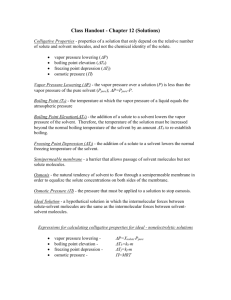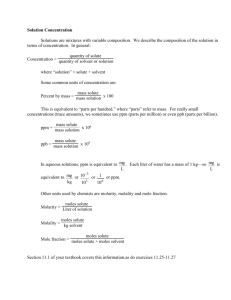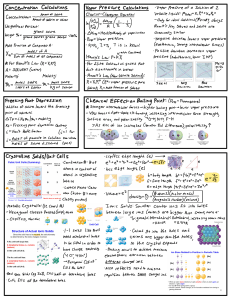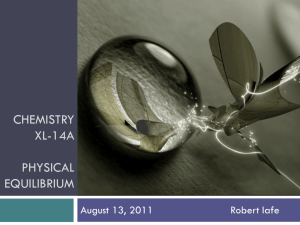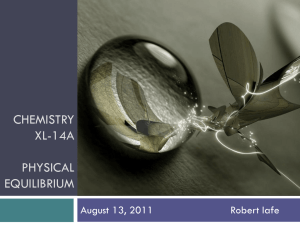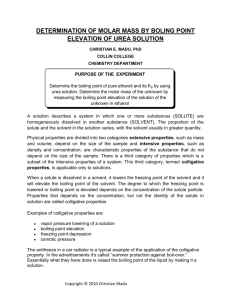CHEM 111 Hour Exam One Review
advertisement
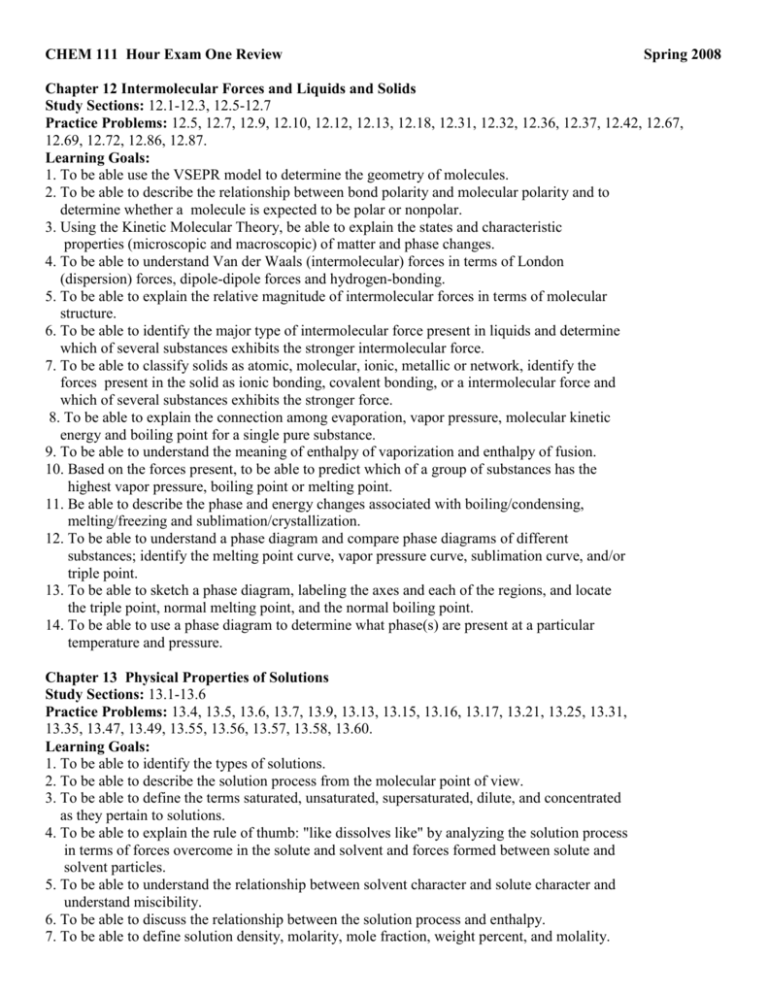
CHEM 111 Hour Exam One Review Spring 2008 Chapter 12 Intermolecular Forces and Liquids and Solids Study Sections: 12.1-12.3, 12.5-12.7 Practice Problems: 12.5, 12.7, 12.9, 12.10, 12.12, 12.13, 12.18, 12.31, 12.32, 12.36, 12.37, 12.42, 12.67, 12.69, 12.72, 12.86, 12.87. Learning Goals: 1. To be able use the VSEPR model to determine the geometry of molecules. 2. To be able to describe the relationship between bond polarity and molecular polarity and to determine whether a molecule is expected to be polar or nonpolar. 3. Using the Kinetic Molecular Theory, be able to explain the states and characteristic properties (microscopic and macroscopic) of matter and phase changes. 4. To be able to understand Van der Waals (intermolecular) forces in terms of London (dispersion) forces, dipole-dipole forces and hydrogen-bonding. 5. To be able to explain the relative magnitude of intermolecular forces in terms of molecular structure. 6. To be able to identify the major type of intermolecular force present in liquids and determine which of several substances exhibits the stronger intermolecular force. 7. To be able to classify solids as atomic, molecular, ionic, metallic or network, identify the forces present in the solid as ionic bonding, covalent bonding, or a intermolecular force and which of several substances exhibits the stronger force. 8. To be able to explain the connection among evaporation, vapor pressure, molecular kinetic energy and boiling point for a single pure substance. 9. To be able to understand the meaning of enthalpy of vaporization and enthalpy of fusion. 10. Based on the forces present, to be able to predict which of a group of substances has the highest vapor pressure, boiling point or melting point. 11. Be able to describe the phase and energy changes associated with boiling/condensing, melting/freezing and sublimation/crystallization. 12. To be able to understand a phase diagram and compare phase diagrams of different substances; identify the melting point curve, vapor pressure curve, sublimation curve, and/or triple point. 13. To be able to sketch a phase diagram, labeling the axes and each of the regions, and locate the triple point, normal melting point, and the normal boiling point. 14. To be able to use a phase diagram to determine what phase(s) are present at a particular temperature and pressure. Chapter 13 Physical Properties of Solutions Study Sections: 13.1-13.6 Practice Problems: 13.4, 13.5, 13.6, 13.7, 13.9, 13.13, 13.15, 13.16, 13.17, 13.21, 13.25, 13.31, 13.35, 13.47, 13.49, 13.55, 13.56, 13.57, 13.58, 13.60. Learning Goals: 1. To be able to identify the types of solutions. 2. To be able to describe the solution process from the molecular point of view. 3. To be able to define the terms saturated, unsaturated, supersaturated, dilute, and concentrated as they pertain to solutions. 4. To be able to explain the rule of thumb: "like dissolves like" by analyzing the solution process in terms of forces overcome in the solute and solvent and forces formed between solute and solvent particles. 5. To be able to understand the relationship between solvent character and solute character and understand miscibility. 6. To be able to discuss the relationship between the solution process and enthalpy. 7. To be able to define solution density, molarity, mole fraction, weight percent, and molality. 8. To be able to calculate density, molarity, mole fraction, weight percent, and molality, given the amounts of solute and solvent. 9. To be able to perform calculations inter-converting density, molarity, mole fraction, weight percent, and molality. 10. To be able to discuss the factors affecting the solubility of a solute in a given solvent. 11. To be able to explain the effect of temperature on solubility. 12. To be able to describe the relationship between temperature and solubility of gases in liquids. 13. T o be able to describe qualitatively the effect of adding solute on the physical properties of a solvent; freezing point, boiling point and vapor pressure. 14. To be able to compute the freezing point depression and the boiling point elevation of a solvent when a known amount of a nonvolatile solute is dissolved in the solution. Chapter 14 Chemical Kinetics Study Sections: 14.1-14.4. Practice Problems: 14.5, 14.6, 14.15, 14.16, 14.17, 14.18, 14.19, 14.23, 14.24, 14.33, 14.34, 14.36. Learning Goals: 1. Be able to explain the collision theory of reactions and analyze the factors affecting reaction rates in relation to the kinetic molecular theory. 2. To be able to understand rate laws and write a rate law given experimental data, know the meaning of order with respect to specific reactants , know the meaning of overall order, and derive the units of the rate constant. 3. From a table of initial concentrations of reactants and initial rates, to be able to determine the order of reaction with respect to each reactant, the overall order of reaction, and the rate law, and calculate the rate constant, and the initial rate for any other set of initial concentrations. 4. To be able to understand that rate laws must be determined experimentally and understand graphical methods for determining whether reactions are first order or not. 5. To be able to use integrated first order rate law to find the value of one variable, given values of the other variables. 6. To be able to understand the half-life of a first order reaction and use the expression for halflife to determine t1/2 from k, or vice versa. 7. Given t1/2 and the time of a first order reaction, in multiples of t1/2, to be able to calculate the fraction of reactant remaining, in powers of 1/2 and vice versa. 8. Given the fraction of reactant remaining, in powers of 1/2, to be able to determine t1/2. 9. To be able to understand the meaning of activation energy and activated complex, the relationship between temperature and formation of the activated complex and the relationship between temperature and rate and rate constant 10. To be able to prepare an Arrhenius plot from rate constant and temperature data and determine the activation energy from the slope of the line. Chapter 21 Nuclear Chemistry Study Section: 21.3 Practice Problems: 21.24, 21.25, 21.26, 21.29, 21.66, 21.68. Learning Goals: 1. To be able to use rate data and the integrated first-ordered rate law to determine the decay constant of a radioactive decay reaction. 2. To be able to interconvert between half-life and decay constant. 3. To be able to use the integrated first-order rate law and half-life to determine the ratio of the number of nuclei remaining at any time relative to the initial number of original nuclei. 4. To be able to use radioisotope dating to determine the age of an object.






